|
 |
Not holding company shares proves to
be costly for towerco CEOs
December 27, 2010 - Regarding insider transactions, financial manager Peter Lynch says executives can sell their stock for any reason, but they only buy for one: They're 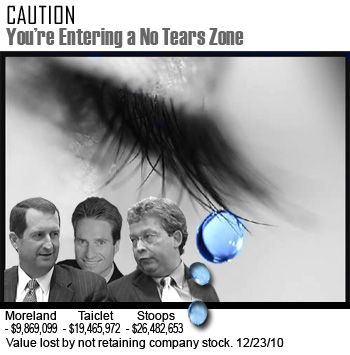 positive about their company's future and believe the price is going to go up. positive about their company's future and believe the price is going to go up.
If you were to rely upon the celebrated money manager's advice, you might question whether you should buy shares in the three publically traded tower companies since the current CEOs have never opened their wallets, according to www.gurufocus.com, to invest in their company no matter how encouraging their forward looking statements are at conferences and investor presentations.
In addition, instead of holding their shares they're more prone to sell big chunks of their option grants when they're vested.
Conversely, just because insiders are selling their shares, such as American Tower Corporation CEO James Taiclet, Jr.'s planned sale of 88, 927 shares last Monday for $4.5 million, doesn't mean that they believe their company's shares will plummet.

In fact, their trades have shown just the opposite.
If Taiclet had held his stock over the years he would have seen a valuation increase of $19.5 million.
Crown Castle CEO W. Benjamin Moreland fared better with a loss of $9.9 million, but SBA's CEO Jeffrey Stoops' sales cost the executive $26.5 million based upon SBA's closing price of $40.11 on December 23, 2010.
One of Stoops' trades of 62,500 shares at $11.41 on November 24, 2008 would have been worth an additional $18 million last week.
The website says that the only tower company CEO that ever bought stock in their company was former American Tower CEO Steven Dodge in 2003. If Dodge retained his 100,000 shares purchased for $921,000, they would be worth over $5 million today.
Some executives may not have the cash available to plow into company shares, say market researchers. Some CEOs face tax bills on shares they received as compensation.
In fact, executives are looking to reduce their risk, not increase it. There's been an increase in the number of executives entering so-called forward sales contracts, says Leland Bettis at market research firm Gradient Analytics. "These contracts help executives protect themselves financially from the risk of falling stock values by locking in a sale price now for shares they plan to sell in the future," Leland said.
However, before you start anguishing over the tower company executives' paper losses and entertain the idea of a corporate-wide cake  sale, you might consider another meaningful philanthropy. sale, you might consider another meaningful philanthropy.
According to www.Forbes.com, Stoops' total compensation for 2009 was $2,706,503. Moreland made $3,720,491 and Taiclet received $16,410,000, buoyed by $14 million in stock gains.
-
|
Year could see fatality average down with a higher age of deceased climbers
December 20, 2010 - If safety observance and compliance continues until the end of the year the industry will have suffered a loss of seven tower climbers - a drop from the 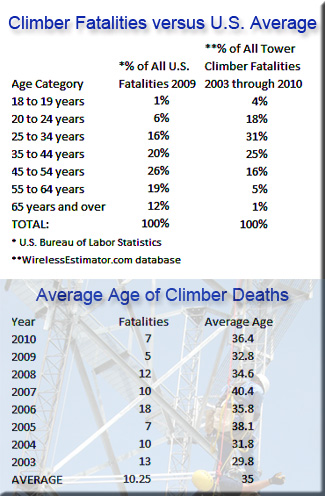 average 10-plus yearly fatality rate seen during the past seven years. average 10-plus yearly fatality rate seen during the past seven years.
Throughout that same period the average age of 82 deceased climbers was 35 years. In 2010 the average was 36.4 years.
Compared to the national occupational deaths in age groups listed by the Bureau of Labor Statistics for 2009, tower workers had higher percentages of fatalities in all categories through the age of 44.
But some industry observers believe that it would be unreasonable to conclude that tower climbers are more prone to die at an earlier age.
"Their [BLS] averages are made up of every single occupation in America. You can't begin to compare our industry with their numbers," said a vice president of a tower construction company that employs more than 80 field personnel who climb.
"A lot of climbers will move on to management and supervisory positions after a number of years or they'll just leave the industry after it becomes too physically demanding when you're in your late forties," he said.
Whereas the highest fatality percentage last year in the nation was 26% of all deaths in the age category between 45 and 54-years-of-age, tower climbers over a seven year period had only 16% of the industry's deaths in that age group.
Higher ages also dropped dramatically. The next two BLS categories totaled 19% and 12%, but tower worker deaths were only 5% and 1% respectively.
Inexperience doesn't appear to be a connecting thread
The lower than average industry deaths have resulted in a year where infrastructure construction has been the busiest in many years.
The surge in business is reflected by increased revenues and a robust employment market that has seen year to year help wanted ads rise almost 300%.
There appears to be no correlation that this year's hot market is causing green hands to die, an often repeated statement.
Complacency and jobsite hazard assessments emerge as primary factors for the resulting fatalities.
Three of the deaths in 2010 were not attributed to climber error or a fall protection equipment failure, the most common causes of a fatality.
One tower technician died in August after the experienced owner of the company he worked for tipped the lift truck he was attached to.
Two tower workers securely tied off to a tower were killed when a boom truck clipped a guy wire and the tower collapsed.
Another fatality in Philadelphia involved a tower technician who fell off a rooftop.
Of the three remaining deaths, an 18-year-old Missouri man was the only climber with limited experience when fell to his death from a 200-foot self supporting tower.
A 36-year-old tower technician with a number of years of experience fell to his death in Lake City, Florida.
A 51-year-old Arkansas man with over 37 years of experience plummeted 100 feet to his death in February.
-
|
Authorities seeking tower tech for possibly 20 or more copper thefts in the southeast
December 17, 2010 - Charlotte, N.C. police believe a former technician for a tower construction contractor used cell site lock information to break into tower sites 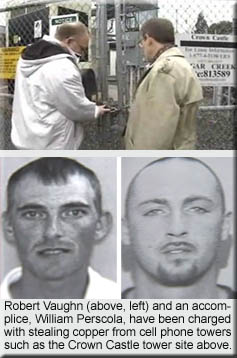 and steal hundreds of pounds of copper cable. and steal hundreds of pounds of copper cable.
Officers have issued warrants charging 30-year-old Robert Vaughn III with breaking into two cell phone tower sites in Mecklenburg County, but they said he's a suspect in more than a dozen others in the area and as many as 20 more in South Carolina and Georgia.
“He was terminated about four months ago but still had the documents needed for gate authorization," said Officer Brian Wakeland, with the Charlotte-Mecklenburg Police Department’s Hickory Grove Division.
Wakeland said Vaughn and an accomplice, William Perscola, were caught breaking into a cell phone tower in east Charlotte last month, and documents found in their van could tie them to dozens more cases in South Carolina and Georgia.
In each case, Wakeland said the men would spend about 30 minutes cutting cables and hauling away copper wire that is bringing a high premium on the metals market.
"When you figure they're getting 200 to 300 pounds per site -- you've got a lot of copper there," Wakeland said.
Wakeland said police have warrants for Vaughn's arrest but they think he is on the run, possibly in the Boone area.
Perscola turned himself in at the Mecklenburg County jail Tuesday night and is free on bond.
Thieves will target cell sites since the copper is easily identified from outside of a locked compound.
A number of times this year those arrested, like Vaughn, had industry experience and used their inside knowledge to strip cell sites.
Last August authorities arrested three technicians for stealing copper as well as generators from a customer they reportedly did work for.
-
|
Arctic blast chills wireless construction projects
December 13, 2010 - A blast of Arctic air — which brought blizzard conditions to the Midwest over the weekend, collapsed the roof of the Metrodome in Minneapolis and forced hundreds of 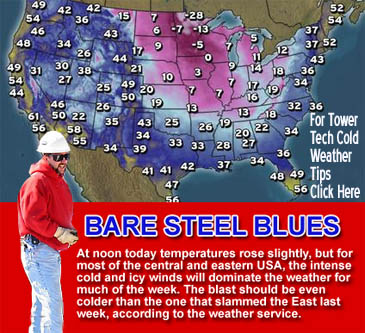 flight cancellations — was sweeping down the Eastern Seaboard early today, forcing many tower construction companies to either cancel existing builds or cut their crews to a few hours of work. flight cancellations — was sweeping down the Eastern Seaboard early today, forcing many tower construction companies to either cancel existing builds or cut their crews to a few hours of work.
Although crews will work in extremely cold weather, production can have a crippling effect on the bottom line for companies that observe safe working procedures, says Tom Frerich, Executive Vice President of Stockton Construction Group LLC, an Illinois-based tower company.
"Last week a new build site should have taken about five days, but it took over seven," said Frerich.
On the agenda early this week for Frerich's company is stacking a monopole, putting in a retaining wall and installing an LTE site. However, those projects may have to be put on hold, especially the concrete work where maintaining the minimum temperature of the concrete may prevent the pour.
Frerich said that he had to pull a crew this weekend after wind gusts accelerated to over 40 miles-per-hour and the wind chill was -19 F.
"One of the hardest things to do in this weather is weatherproofing, where people will have to heat the butyl under their armpits," Frerich said.
'Tis the season not to be jolly, says Gene Stout.
The Data Cell Systems construction supervisor had to make a decision early this morning to bring in a crane to stack a 330-foot self supporting tower near Alexandria, Minnesota.
However, in order to meet the customer's deadline, Stout said it was necessary.
To his crew's advantage, heavy winds had blown the work area fairly clear since the site is on a hill, however, he said that what should normally be done in a day with a crane - due to the extreme cold - would take an additional day.
A crane capable of the required picks runs approximately $500 per hour.
"Fortunately, right now they're offloading steel and assembling sections," Stout said.
Stout's Lonsdale office is the furthest north of Data Cell's six regional offices.
However, even Florida tower crews were hampered by extreme cold where temperatures hovered below freezing today.
For tips on how to protect workers from cold weather injuries, click here.
-
|
SBA Communications' safety culture starts
at the top of the tower company
December 5, 2010 - Typically when a major tower company is quoted in the press it's in relationship to increased earnings and new acquisitions.
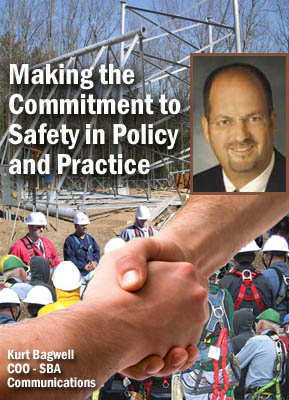 However, the nation's third largest public tower company, SBA Communications of Boca Raton, Fla., is being heralded lately for their efforts to actively engage the industry in advancing worker safety. However, the nation's third largest public tower company, SBA Communications of Boca Raton, Fla., is being heralded lately for their efforts to actively engage the industry in advancing worker safety.
Earlier this year David Sams, Director of Risk Management for SBA, was recognized as one of the prime architects in the development of the National Association of Tower Erectors' Tower Site Hazard Recognition Guide, NATE's first educational resource designed to educate all facets of the industry on tower safety.
Sams said that improving safety in the tower industry should be paramount for tower companies, wireless companies, broadcasters, owners and operators.
Unlike a number of tower companies, where safety initiatives are the responsibility of safety and health managers, SBA's creation of a culture of safety and ensuring that everyone goes home safely each night starts at the executive level.
“During the past decade our industry has had too many serious accidents related to falls from towers. Many of them were due to lack of training or lack of following procedure," said Kurt Bagwell, Senior Vice President and Chief Operating Officer of SBA, who stated that the company's management team decided to establish a safety program that not only benefited their workers but at the same time could reduce cost associated with building sites and maintaining their towers.
"Once we felt that our program was successfully integrated we adjusted our thought process towards reducing accidents as it relates to contractors performing work for our services division."
"We began mandating that contractors who were going to work for us needed to meet certain safety criteria and safety training. Our safety department was charged with enforcing our safety policies on subcontractors through job site auditing," Bagwell said.
He stated that the auditing program includes ensuring that contractors have proper safety procedures in place and that their employees meet the training guidelines for working at heights.
"We have had a very successful track record over the years at our sites and on our services jobs and think it is sustainable," Bagwell said.
Whereas Bagwell might not be inclined to discuss some of the operational plans contributing to SBA's exceptional growth, he is anxious to talk to other tower companies and share his insight.
He will be the featured speaker at NATE's 16th annual conference and exposition on February 22, 2011 and will address attendees on the topic of "Making the Commitment to Safety in Policy and Practice."
"We look forward to continuing our work with NATE to help promote a safe work environment in the tower industry,” Bagwell said.
Bagwell started with SBA in 2001 and became the company's Chief Operating Officer a year later. His current duties include the day-to-day management of the company’s 8,600 tower portfolio, management of the Services Division, their new tower build efforts, International Operations as well as the Managed Site Division.
He is in his 22nd year in the wireless industry, having held various management positions with carriers. While with Sprint PCS he oversaw the initial buildout of the Eastern United States, in addition to the expanded buildout of over 10,000 cell sites nationwide.
Sams will be a panelist at one of the event's educational sessions: "Who's in Charge? Violations and Misinterpretation of the Multi-employer Workplace Policy and How it Affects Contractors and Site Owners - and Ways to Protect Your Company."
For complete show details and registration information, click here.
-
|
NATE's new accident prevention, safety
and health program guide available
December 4, 2010 - The National Association of Tower Erectors has released the fourth edition of its Accident Prevention, Safety and Health Program Guide.
This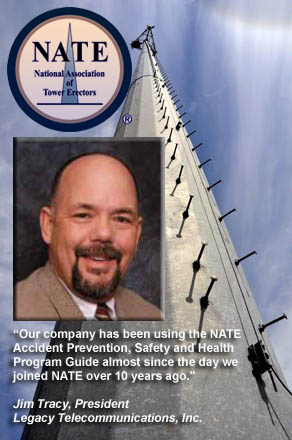 resource provides valuable and relevant safety information to tower erectors, allowing NATE members to continue raising the bar for industry safety as qualified contractors. resource provides valuable and relevant safety information to tower erectors, allowing NATE members to continue raising the bar for industry safety as qualified contractors.
Developed in 1995, the guide is the benchmark safety program for the tower erection service and maintenance industry, designed for use by tower erectors to enhance their own company safety program. The guide contains suggested formats and procedures for fall prevention, hazard identification and tower access, and samples of a climber exam, evaluation form and much more.
Updated regularly to ensure all referenced industry standards and OSHA regulations are current, this new version includes revisions based on the American National Standards Institute (ANSI) updated fall protection standard and a number of OSHA regulations that have been revised.
"Our company has been using the NATE Accident Prevention, Safety and Health Program Guide almost since the day we joined NATE over 10 years ago," said Jim Tracy, President of Legacy Telecommunications, Inc., a NATE member company.
"The Guide has been indispensible in demonstrating the necessary components of a health and safety program, both in keeping my employees safe, and in making sure we are aware of and following applicable regulations," Tracy said.
The new edition includes the addition of:
- Hazard Identification – Definition, identification of methods to identify hazards, analyze hazards and develop solutions, and a new Job Hazard Analysis form;
- Competent Climber Requirements – References to the new ANSI Z359 group of standards;
- Hazard Communication Standard – "Sample Program" and reference/resources list;
- 6RF Exposure – "Frequently Added Questions" and a resource list; and
- Emergency Response – "Emergency Action Plan" section as required by OSHA.
"The NATE Accident Prevention, Health and Safety Program Guide is an outstanding example of what all associations should be doing for their members," said Mark Lies, partner, Seyfarth Shaw LLP. "NATE members should utilize this resource for guidance on how to assemble an effective safety and health program for protecting employees, developing best practices and staying in compliance with federal regulations."
"As the leader in safety for the tower erection, maintenance and service industry, it's critical for NATE to keep its members informed of the ever-changing requirements and regulations," said Jim Coleman, NATE Chairman of the Board of Directors. "Times change, processes change and standards and law change. Training is an ongoing process that is never complete. NATE updates the Accident Prevention, Safety and Health Program Guide as needed to ensure it remains a valuable resource for improving tower climber safety throughout the industry."
For more information on the NATE Accident Prevention, Safety and Health Program Guide or other tower safety resources, please visit www.natehome.com.
-
|
Crane and crew cave in to two dozen protestors
November 22, 2010 - With permit in hand, a New York metro area telecom contractor 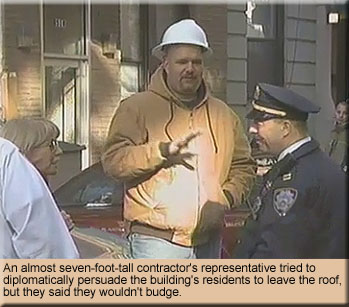 blocked off the road in front of the Salem House at East 81st Street on Manhattan's Upper East Side. blocked off the road in front of the Salem House at East 81st Street on Manhattan's Upper East Side.
Used to setting supporting beams and T-Mobile cabinets throughout the five boroughs, a hydraulic crane operator for Galasso Trucking of Maspeth quickly extended his outriggers and began to get ready for his early Sunday morning pick.
However, two dozen residents quickly surfaced on the 164-unit building's rooftop and protested the cell site lift yesterday morning, stating that they feared the radiation they would be exposed to, and the 30-year plan with T-Mobile was devised behind closed doors by the condo board members only.
Authorities were called and a NYC police captain tried to mediate the conflict to allow the contractor to proceed.
The residents wouldn't move, stating they would stay there all day if necessary, and it was decided by either T-Mobile or the contractor to forego the installation since any work on the roof would endanger the protesters.
Jane Builder, a spokeswoman for T-Mobile, released the following statement: “We’ve worked with the resident-elected board of directors at the Salem House for more than a year to bring a new site on-air that blends in with the surrounding area and delivers the biggest service improvement for local families.”
First attempt to permanently remove the site failed
This is not the first time the contractor has been shut down by residents of the tony 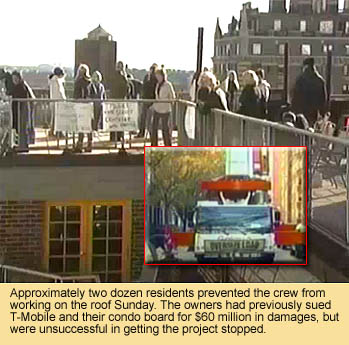 condo. condo.
Construction work was put on hold after owners sued their condominium board and T-Mobile in March, arguing the equipment was put in without the tenants' consent and it was surrounded by warning signs, showing it was bad for their health.
They asked for $60 million in damages in addition to having the project scrapped.
T-Mobile, which said it had already spent $270,000 on the work, countered that the signs are required by the Federal Communications Commission, and besides, only the FCC has control over telecommunications facilities.
Supreme Court Justice Louis York agreed in July.
"This Court has seen no basis to assume that the installation of these facilities will cause harm to the users of the roof," he wrote. "But even if such harm were provable, injunctive relief would be denied" because federal law takes precedence.
The project, however, was still unable to proceed due to a stop-work order issued by the Buildings Department after contractors punctured a partition.
If T-Mobile resolves the issue with Salem House's board members and condo owners, remobilizing will be expensive. The crane could cost as much as $5,000 or more on Sunday and the crew along with another street closure permit could run up the tab in excess of $9,000 or more.
The amount appears to be a legitimate change order request that would be borne by T-Mobile.
"Don't bet on it," said another metro-area contractor. "It could be a bit of a dog fight, depending upon whether it was T-Mobile or the contractor who decided to shut down the job."
New York City's construction embargo begins today through January 2, 2011, restricting cranes from operating on numerous streets during the holiday season.
-
|
Accidents in Kentucky and Vermont injure two tower techs, one seriously
Update: November 23, 2010 - A 35-year-old Massachusetts tower tech injured last Friday after falling 60 feet off of a monopole in Hartford, Vt. is expected to recover from his injuries and is likely to be released from the hospital in the next day or two, according to individuals knowledgeable of the accident.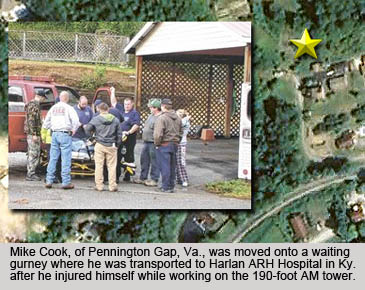
The employee of Infinite Solutions, Inc. of Wilmington, Mass. fell while working on an AT&T project on a 78-foot monopole owned by SBA Communications Corporation.
Infinite was a subcontractor to SAI Communications, Inc. of Salem, N.H.
In 2009 a subcontractor of Infinite collapsed an AT&T monopole in Wellesley, Mass. after its transmission lines caught fire. - - - - - - - - - - - - -
November 21, 2010 - The week finished with two tower technicians receiving injuries on the job, one seriously hurt when he fell 60 feet in Vermont.
A Virginia man was injured after a fall while working on a 190-foot AM tower in Baxter, Ky. on Tuesday.
According to Lt. James Billings of the Harlan City Fire Department, the Harlan County Rescue Squad was notified by the Harlan Police Department that a man was hanging injured from the WFSR tower located off Rodgers Lane.
Billings said when emergency personnel arrived on the scene, they observed the man had managed to free himself from the tower and was lying approximately three to four-feet away from the tower.
WFSR station manager Jeff Capps said the injured man was Mike Cook, of Pennington Gap. Cook was reportedly working on the tower alone.
He was transported to Harlan ARH Hospital where he was treated for a broken shoulder.
Eastern Broadcasting Co., Inc. owns the tower that broadcasts a gospel radio format.
Serious injuries in Vermont fall
In Hartford, Vt. an unidentified 35-year-old Massachusetts tower tech was seriously 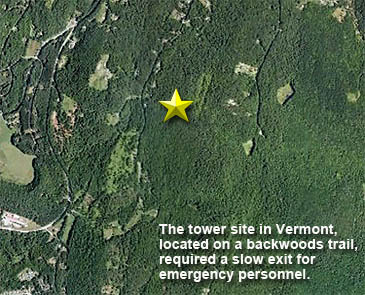 injured on Friday after surviving a 60-foot fall off of a monopole. injured on Friday after surviving a 60-foot fall off of a monopole.
Authorities say the tower tech was wearing personal fall protection equipment when he
fell 50 feet and then struck the roof of an equipment shelter at the base of the tower before rolling off that structure and falling the remaining 10 feet to the ground where he remained conscious and alert although he was in a lot of severe pain with injuries and possible fractures to his back, neck, legs and arms, rescuers said.
“They did all have ropes set up and they did all have harnesses on, but I’m not sure what happened from there. I couldn’t give you any answers as to how he ended up falling,” said Hartford Fire Lt. David Rowlee, who was in charge of the hour-long rescue effort that began with a 911 call just after 11 a.m.
“The only thing technical about the rescue was the location on a backwoods trail, but we were able to get our ambulance in there so it really wasn’t that much of an issue. It was just a very slow trip out,” Rowlee said
Authorities said that they could not immediately provide the owner of the structure, the name of the contractor and the company the crew was working for.
The Bliss Road address provided by authorities, according to FCC records, indicates that it is an SBA Communications Corporation-owned monopole. SBA lists the height at 78 feet.
-
|
Kansas station tagged with $25,000
FCC fine for safety related issues
November 17, 2010 - An FCC enforcement bureau district field office issued a Notice of Apparent Liability, proposing to fine a Kansas radio station $25,000 for violations 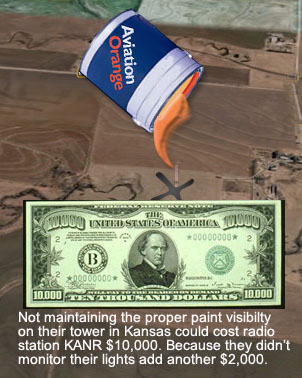 including an EAS system that was not operational, as well as a tower that needed repainting and with lights that were not functioning properly. including an EAS system that was not operational, as well as a tower that needed repainting and with lights that were not functioning properly. On the 498-foot guyed tower issues, the FCC found that the obstruction lighting, which were required to be flashing, were either not operational at all or not flashing, and that the licensee, Daniel Smith admitted that no visual inspection of the lights had occurred in at least a week.
Citing Section 17.47 of the FCC rules, which require a visual inspection of tower lights every 24 hours unless there is an automatic inspection system, the FCC found that there was a violation on the structure that broadcasts a Spanish language station, Fiesta 92.7 FM.
Smith stated that he was aware that the side lamps were inoperable on the Riverdale tower, but was unaware of the non-flashing condition of the lights. He had no logs or records documenting his observations or any failures in the lights.
In addition, the inspection revealed that the tower paint was faded and, in some places, had peeled to reveal bare steel, as the tower had not been painted since 1996, according to Smith. Towers must be cleaned and painted "as often as necessary to maintain good visibility" under Section 17.50 of the FCC Rules.
Smith's failure to monitor the tower lights resulted in a $2,000 fine, and a $10,000 fine was imposed for not repainting the tower.
In connection with the EAS equipment, the station had a disconnected receiver, which had apparently been disconnected for at least four years, and perhaps as many as 10 years. The licensee blamed the failure on the inability to find an engineer who could repair the malfunctioning equipment.
The failure to have an operational system, and the failure to log the required weekly and monthly EAS tests, resulted in an $8,000 fine, which was adjusted upward to $9000, as Smith has a history of not maintaining operational EAS equipment at this station, according to the FCC.
To add to these technical fines, the FCC found that the station had no quarterly issues programs lists for 2009 and 2010, adding $4,000 to the total fine.
The FCC says that Smith's violations must be corrected by December 10.
The Notice of Apparent Liability is available here.
-
|
Hearing dates set to assess impact of FCC's antenna structure registrations
November 17, 2010 - To comply with obligations under the National Environmental Policy Act the FCC has announced that it will be holding a series of three hearings to assess the environmental impact of its Antenna Structure Registration (ASR) program.
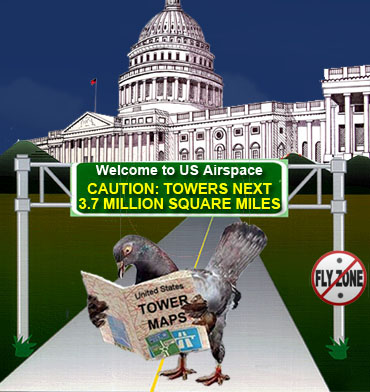 The inquiries are required by the FCC after a federal appeals court ruled in 2008 that the federal agency had not adequately assessed its obligations under NEPA with respect to the impact of communications towers on migratory birds after there were claims that towers killed millions of birds each year. The inquiries are required by the FCC after a federal appeals court ruled in 2008 that the federal agency had not adequately assessed its obligations under NEPA with respect to the impact of communications towers on migratory birds after there were claims that towers killed millions of birds each year.
The hearings are to review the Commission's ASR process to gather evidence to determine whether a more extensive analysis of the potential environmental impact of tower construction is necessary when towers are constructed or modified.
The hearings will explore the following categories:
Category #1 - New Towers taller than 450 feet above ground level.
ASRs always require inclusion of an EA upon filing.
ASRs will always be placed on Public Notice by the FCC.
Category #2 - New Towers of a height of 351 to 450 feet AGL.
ASRs do not initially require an EA based on avian concerns.
ASRs will always be placed on Public Notice by the FCC. The FCC will determine whether an EA is necessary for Category #2 ASRs after reviewing the ASR application and any filings made in response to the Public Notice.
Category #3 - New Towers of a height no greater than 350 feet AGL,
Replacement Towers and Minor ASRs.
ASRs do not require an EA upon filing based on avian concerns.
The hearings will be held in Washington on December 6, in Chula Vista, Calif. on December 13, and in Tampa, Fla. on December 15. Information about the proceedings is available in the FCC's Public Notice.
The deadline for comments on the Commission's evaluation of its ASR program are due by January.
After extensive negotiations, the National Association of Broadcasters last May and six other organizations submitted to the Federal Communications Commission a Memorandum of Understanding (MOU) that contained recommendations designed to help the FCC protect migratory birds. Additional information can be found here.
-
|
Clearwire's unexpected warning was required,
but is still troubling for contractors
November 11, 2010 - Clearwire Corp disclosed late last week that it may not have enough funding to keep operating its business.
The carrier's "going concern" notice does not mean that Sprint Nextel Corp and its 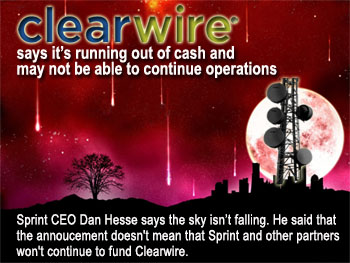 other partners would not continue to fund the company, the head of Sprint said this week. other partners would not continue to fund the company, the head of Sprint said this week.
Sprint Chief Executive Dan Hesse said the notice was an accounting technicality due to the fact that Clearwire has less than 12 months worth of funding left.
However, Hesse did not confirm his company is actually prepared to provide more funding to Clearwire.
In addition, a pricing row has strained the partnership. Both companies entered into arbitration last October on a dispute over wholesale pricing for the 4G smart phones offered by Sprint.
Clearwire has said that it hopes to announce a new round of funding by the end of the year. Analysts say they expect Sprint to pour more money into the venture as it depends on Clearwire for advanced services.
The company is cutting 15 percent of its workforce, reducing sales and marketing spending and delaying its Clear-branded smart phone as part of a plan to save between $100 million and $200 million this year, according to a company statement.
The Kirkland, Washington-based company has 4,200 employees, putting the cuts at about 630 jobs.
Clearwire currently has thousands of sites in various stages of planning and construction beyond its current build plan, and it intends to suspend zoning and permitting in a portion of those sites until such time as additional funding becomes available.
The unprofitable company is the mainstay of a number of tower construction and site acquisition companies throughout the country.
Suppliers are also monitoring Clearwire's retrenchment. One distributor said they have seen a marked downturn in orders this week due to projects being placed on hold.
- |
Tech's fatality investigation relies upon questionable OSHA report
November 8, 2010 - A New Jersey tower tech's death in 2008 has been investigated by a federal agency, but their recommendations to the tower construction industry may have been guided by an OSHA compliance officer's questionable report.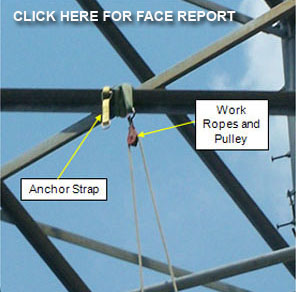 The National Institute of Occupation Safety and Health's (NIOSH) Fatality Assessment and Control Evaluation (FACE) program investigates fatalities in order to offer prevention advice, but the program's guidelines identify that the report does not determine fault or place blame on employers or individual workers. The National Institute of Occupation Safety and Health's (NIOSH) Fatality Assessment and Control Evaluation (FACE) program investigates fatalities in order to offer prevention advice, but the program's guidelines identify that the report does not determine fault or place blame on employers or individual workers.
However, their most current report after an industry absence of almost five years identifies what could have been done to prevent the accident, inferring that a separate lifeline with a rope grab might have saved a life.
In the fatality accident where Gerard M. LeClercq, 55, was working on a Crown Castle International self supporting tower at approximately the 60-foot level, the N.J. FACE investigator provided recommendations based upon information obtained from interviews, examination of the fatality site and related equipment.
Additional information was obtained from the medical examiner’s report, OSHA communication tower experts, and the OSHA compliance officer’s final report, an account that an OSHA administrative law judge ruled in June was highly questionable.
In a stinging rebuke, Judge Covette Rooney said the New Jersey compliance officer misinterpreted the statements of witnesses. Judge Rooney also credited the testimony of the erector's employees over the inspector's findings.
The FACE report was completed on March 10, 2010, prior to Judge Rooney's ruling, but wasn't released by the NIOSH until November 4.
Following her investigation in 2008, the compliance officer said she was convinced that LeClercq was using a Fisk Descender to perform a controlled descent when he fell and cited Paramount Advanced Wireless, LLC of Pennsauken, N.J. with a serious violation and proposed a penalty of $7,000.
Testimony at the hearing identified that controlled descending was not being used at the accident location.
Judge Rooney agreed and vacated the fine.
The FACE investigation said "A separate fall arrest system could have prevented this incident."
Judge Rooney disagreed in her ruling, stating that it was the climber's error and not the lack of proper safety equipment on the job site.
In her ruling, she stated, "Accordingly, I find that on this record, respondent established that the accident was an unforeseeable event caused by the idiosyncratic actions of the employee who, for some unknown reason, unhooked himself from his fall protection," said Judge Rooney in her ruling.
Attorney finds fault with FACE investigation
Attorney Daniel R. Flynn, who along with Mark A. Lies II of Seyfath Shaw LLP represented Paramount at the administrative hearing before Judge Rooney, said he was concerned about the inaccuracies in the report.
"The facts on which each one of the three recommendations set forth in the FACE report is based are inaccurate and contrary to the findings of the Occupational Safety and Health Review Commission following an adjudicated hearing concerning the accident."
"Judge Rooney specifically found that Mr. LeClercq was not performing a controlled descent at the time of the accident, but rather was using the Fisk Descender as a work positioning device coupled with both a positioning and a shock-absorbing lanyard -- a proper way to maintain 100% fall protection."
"Further, Judge Rooney lauded the company's safety program, finding that the company 'has a well-communicated, comprehensive and properly enforced safety program that requires employees to be properly tied off at all times they are on the towers.' The program included extensive ComTrain training as well as daily hazard assessments, toolbox talks, and equipment inspections," Flynn said.
A request to the New Jersey FACE program's principal investigator has been made to identify whether Judge Rooney's statements will have any effect upon their published report.
The state-based FACE reports are funded and published by NIOSH, a division of the Centers for Disease Control and Prevention (CDC) in the Department of Health and Human Services.
_
|
Harris says its public safety radio system
cuts out the need for towers
November 2, 2010 - Whenever a statewide public safety radio system bid hits the streets, Harris Corporation, Com-Net Ericsson and Motorola will be 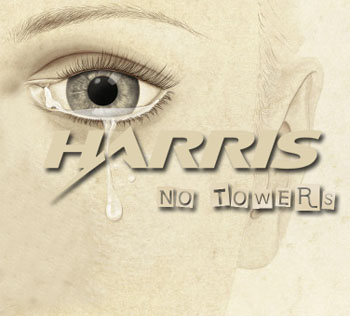 key competitors. key competitors.
Following the award, it is almost expected that one or more of the players will protest the winner's capability to deliver - or that its system did not meet the specifications - and lodge a complaint with the state, claiming their evaluation was flawed.
But no matter who eventually won it was always beneficial to the industry.
Tower manufacturers could count on the opportunity to provide the successful company with anywhere from a half-dozen to 40 or more towers, depending upon the contract which could exceed $200 million.
Erectors also lined up for opportunities along with building manufacturers and others looking to provide services and products.
However, Harris Corporation broke the mold today when it announced that it received a $14 million contract by the State of Vermont to deploy a statewide radio system for public safety first responders and state agencies with "virtually no increase in the number of tower sites."
Harris' VIDA® Network Technology will utilize the state's existing UHF and VHF frequencies. The Harris P25 system will deliver full communications interoperability to first responders within the state, the region, and across the border in Canada.
Harris, says that its VIDA Network is a cost-effective, IP-based interoperable radio communications technology that fully complies with the emerging APCO P25 Phase 2 standards and doesn't require any additional towers.
To date, none of the other bidders have protested the award.
In September, Harris Corporation petitioned Illinois Central Management Services' attorney to have the state remove the language with its lease agreement with Motorola to allow other radio vendors to provide radios that are compliant with the P25 StarCom21 system.
Harris said more than 15,000 radios are on the system, but only two are supplied by a vendor other than Motorola, therefore creating a virtual monopoly supported by the contract's restrictions.
The State of Illinois contract provides for a penalty assessment if a non-Motorola radio is deployed onto the network.
-
|
India is reactive in tower collapse concerns, but proactive in RF compliance
November 1, 2010 - After numerous reports of cell towers collapsing on rooftops in India and structural damage being observed, ministry officials have stepped up enforcement to require carriers and tower owners to remove them or identify that the 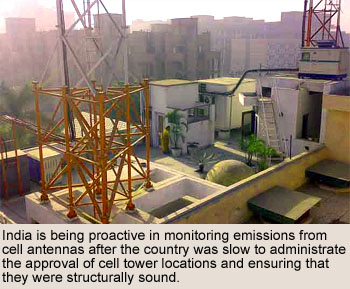 towers meet the country's construction code. towers meet the country's construction code.
In most cities the rooftop and the supporting structure must withstand wind speeds of 85 miles per hour, but during the feverish build-out in India to meet the increasing demand for wireless coverage, thousands of towers were installed on rooftops without the proper approval required.
Whereas India was slow in regulating cell site locations and the mast's structural integrity, it's being proactive in ensuring that its residents are safe from excessive radiation from base station emissions.
Similar to many other countries, India relies upon self regulation by carriers to monitor their emissions by guidelines drawn from the recommendations of the International Commission on Non-Ionizing Radiation Protection.
However, the Minister for Communications and Information Technology Sachin Pilot announced this week that nationwide random testing of radiation would begin on November 16 in a program to be carried out by Telecom Engineering and Resource Monitoring.
Non-compliance would result in fines and penalties.
New York City's antenna monitoring bill dies
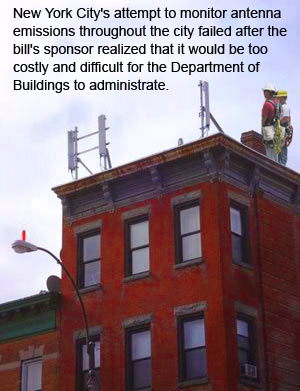 The U.S. relies upon self-certification, but in 2009 New York City introduced legislation that would require the Department of Buildings to monitor the radiofrequency electromagnetic fields emitted by cell site antennas. The U.S. relies upon self-certification, but in 2009 New York City introduced legislation that would require the Department of Buildings to monitor the radiofrequency electromagnetic fields emitted by cell site antennas.
The bill's sponsor, Councilman Vincent Gentile, had a record of being an anti antenna advocate for a number of years, stating in 2005, “Their [cell carriers] claims have about as much validity as the tobacco companies’ [old] claims about the safety of cigarettes!”
The cost to the city was estimated by industry professionals to be as much as $30 million per year.
"The proposed legislation is scientifically naïve and quite impractical to implement. It fails on so many points," said Lawrence Behr, CEO of LBA Group when it was announced last year.
Gentile then obtained relevant information from the wireless industry and realized that his proposed legislation could not be effectively administrated by the Department of Buildings.
The bill died at the end of the Council's 2009 session.
-
|
Crown Castle and T-Mobile fined $10,000 each following propane accident
October 27, 2010 - The Massachusetts Department of Environmental Protection has penalized T-Mobile USA and Crown Castle USA, $10,000 each for failure to timely 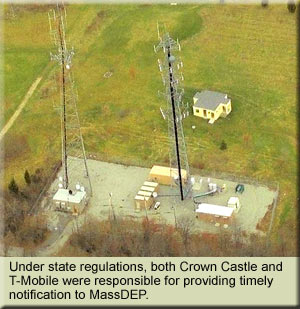 report the release of 400 gallons of propane that occurred from a cell phone tower located at Turkey Hill Lane in Cohasset, MA in August. report the release of 400 gallons of propane that occurred from a cell phone tower located at Turkey Hill Lane in Cohasset, MA in August.
Crown Castle owns the Cohasset cell phone tower and associated compound where the backup generator is fueled by liquid propane stored in an on-site underground storage tank.
Under state regulations, both parties are responsible for providing timely notification to MassDEP following reportable releases of oil or hazardous material.
However, neither of these companies reported the propane-release incident, which occurred at approximately 8 p.m. on August 5, within two hours, as required.
A sub-contractor working on behalf of T-Mobile inadvertently struck the tank's valve during cell tower maintenance work, resulting in the release of 400 gallons and causing a strong odor to permeate the neighborhood.
At approximately 8:15 p.m., the Hingham Fire Department responded to the release. The next morning, the Hingham Fire Department responded again and shut down all maintenance activities upon arrival due to what it deemed the explosive risk posed by the residual propane vapors.
On the morning of August 6, the Cohasset Fire Department also inspected the spill location and subsequently notified MassDEP.
"This type of failure to respond and report a sizeable and potentially hazardous situation like this to MassDEP is not acceptable," said David Johnston, director of MassDEP's Southeast Regional office in Lakeville. "It reveals a lack of understanding from both parties that, in this case, the local fire department fortunately helped address. But this type of failure is preventable and needs to be addressed."
|
Three workers hospitalized after rigging
accident near Utica, New York
Update: October 25, 2010 - The three accident victims were taken to St. Elizabeth Medical Center in Utica, where two remained this evening.
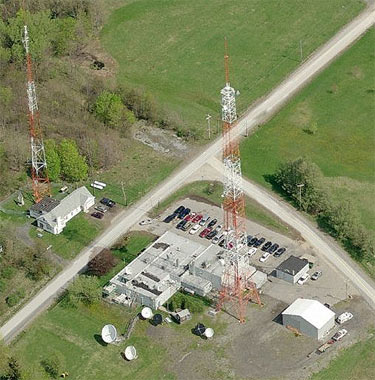 William Fox, 49, suffered severe facial injures, police said, and a hospital spokeswoman said he was listed in fair condition. William Fox, 49, suffered severe facial injures, police said, and a hospital spokeswoman said he was listed in fair condition.
Kelly Dougherty, 30, suffered a foot injury, and he was being evaluated Monday evening, authorities said.
Gregory Campbell, 44, went to the hospital for evaluation and was discharged.
- - - - - - - - - - - - - - - -
October 25, 2010 - Two tower techs fell while working on a WCNY antenna on the WKTV tower on Smith Hill Rd., north of Utica, NY this morning at 11:30 a.m.
A third tower tech hit his head on a tower leg following the rigging accident, but was able to climb his way down and was then transported to a local hospital along with his co-workers.
It is believed that the two men fell a distance between 20 and 40 feet according to the station's management.
The workers, from Alpha Antenna Service, were injured when the antenna that was being installed 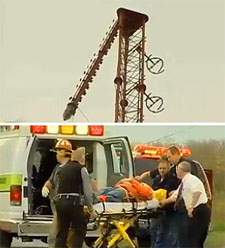 for WCNY’s HD television transmission upgrade for the Utica area snapped, said WCNY spokeswoman Caitlin Pompo. for WCNY’s HD television transmission upgrade for the Utica area snapped, said WCNY spokeswoman Caitlin Pompo.
The antenna tipped over and was dangling, forcing the studio and offices of the station to be evacuated.
A second tower crew of was sent to analyze the damage and make arrangements to secure the antenna.
The station had to broadcast alternate programming until they were able to return to the building after it was identified that they would be safe.
Initial reports from emergency responders said that the tower techs' injuries did not appear to be life threatening.
State Police Trooper Thomas Smoulcey said that the three men were being hoisted up the tower in harnesses to install a new antenna when the accident occurred.
The U.S. Department of Labor's Occupational Safety and Health Administration responded to the scene.
Prior to personnel being lifted, OSHA requires that a trial lift, inspection and proof test must be made.
According to OSHA's 2002 directive, except where an employer can demonstrate that specific circumstances or conditions preclude its use, a personnel platform must be used to hoist more than one employee to their work station.
When a full body seat harness is used to hoist employees, no more than two employees may be hoisted at a time, according to CPL 2-1.36.
The self supporting tower is 367 feet tall and was constructed in 1948.
Alpha Antenna Service, Inc., located in Manlius, NY, was established in 1980. Its CEO is Rodney L. Gifford.
|
FCC sets cell site growth at 7%, but its
flat percentage could be flawed
October 22, 2010 - A white paper issued by the FCC yesterday said that the United States will need another 275 megahertz of spectrum by 2014 to keep up with 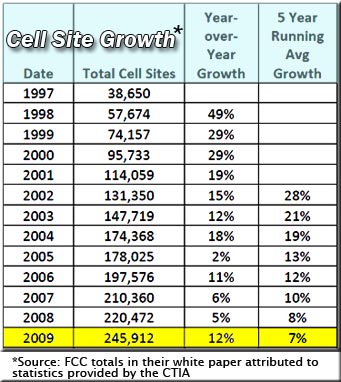 mobile broadband demand. mobile broadband demand.
It also discussed how building new cell sites and operating cell sites more efficiently can offset the need for new spectrum.
The FCC projected growth levels of cell sites at about 7% over the next five years, in part because much of the macrocellular networks already have been built, so cell-site growth will focus on increasing capacity, not coverage.
“This is a more conservative approach than projecting into the future the flattening growth seen in recent years, since new ‘infill’ cell sites that add capacity are a substitute for new spectrum. Additionally, we assume all future cell-site growth will emphasize capacity over coverage, which is also conservative from the standpoint of estimating spectrum needs since new coverage sites do not address capacity constraints,” the FCC said.
In providing their growth projections, the FCC believes that the slowdown in site growth is likely a sign of a maturing industry.
But they're not quite sure and also acknowledged that it might reflect the increasing difficulty of acquiring sites due to scarcity of locations, zoning, and other constraints. Last November, the FCC took action to alleviate some of the regulatory barriers to site expansion when they introduced their shot clock ruling.
The commission determined that state and local governments must review collocation applications within 90 days and all other tower applications within 150 days of submission.
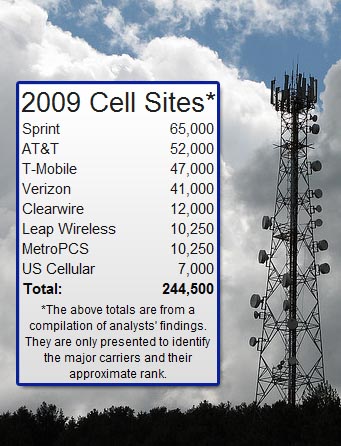 However, according to industry panelists at this month's PCIA conference in Hollywood, Fla., after almost a year they have seen no appreciative shortening of review and approval times. However, according to industry panelists at this month's PCIA conference in Hollywood, Fla., after almost a year they have seen no appreciative shortening of review and approval times.
The FCC said it used data published by CTIA and identified a total of 245,912 sites in 2009.
According to Dr. Robert Roche, who has headed up CTIA's research department since 1993, the tally at the end of 2009 was 247,081.
Roche said that their data gathering is a largely volunteer effort of carriers, and on occasion not all of them respond to CTIA's inquiries.
CTIA reported that at the end of June 2010 there were 251,618 cell sites, a six month increase of 4,537 sites.
If the increase in sites remains the same for the second half of 2010 the year over year increase will be at a five year low of less than 4%.
Low cell site count belies the hot sector
Trying to identify the number of cell sites, and particularly the number of towers in the United States, is a vexing problem for CTIA and PCIA.
Nonetheless, the reduced cell site builds aren't reflected by the current state of the industry, say manufacturers, contractors and employment firms.
"This year has been one of the busiest I've seen in years and I don't see an end in sight," said a recruiter who said he can't keep up with the increased demands for workers in all areas of development and construction.
WirelessEstimator.com's hiring trend tracker mirrors that need with its hockey stick rise that began last August.
The CEOs of major tower companies are equally as enthusiastic about the industry's future, one of them stating at PCIA that he doesn't see this industry slowing down for at least ten to 20 years.
In establishing a 7% growth rate, the FCC reportedly did not consider LightSquared's need for 40,000 new cell sites.
The company expects to add 300 base stations this year, 5,000 by the end of 2011, and around 13,000 base stations in 11 more metropolitan areas in 2012.
|
Erector's association strongly denounces dangerous free climbing video
October 14, 2010 - The National Association of Tower Erectors today publicly 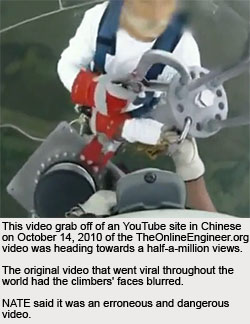 denounced the message of the recently posted video, "Stairway to Heaven," depicting two men climbing a broadcast tower. The video went viral on YouTube and other internet sites throughout the world. denounced the message of the recently posted video, "Stairway to Heaven," depicting two men climbing a broadcast tower. The video went viral on YouTube and other internet sites throughout the world.
In a media release, the organization said that "NATE asserts that the posting of the content was misguided and its messages should not be given credence by any viewer."
It is not known how many viewers watched the video, but an informal count by WirelessEstimator.com identified a minimum of over seven million.
The seven-minute "instructional" video first appeared on TheOnLineEngineer.org's web site, but the tower climber that shot it using a helmet camera, and who approved the edited version, had the site's owner, Russ Brown, take it off after a number of people complained about its troubling inaccuracies.
Brown petitioned YouTube to take the video down after it appeared there, stating it was in violation of his copyright. YouTube complied, but the video again went viral on YouTube from others who had downloaded the original and it also began appearing on Yahoo videos - where one upload had over 2.1 million views - and other blogs and sites throughout the world.
Web sites were contacted by Brown and some agreed to remove it, but he found it to be a daunting task as the climber video popped up quicker than families of meerkats, and he wrote that he was considering letting the video run its course.
NATE said the video incorrectly asserts that free climbing is accepted by OSHA and that “most tower workers climb this way.” They said the video also depicts as standard procedure other dangerous and prohibited conduct not condoned by NATE or OSHA.
"There are many inaccuracies in this video," they said.
The trade group took aim at employers who allow such practices, stating that they will likely cut corners on other aspects of their work.
“If a company or employee will cut corners with the lives of its workers, on what other aspects of work will they be willing to cut corners?” NATE asked.
"Owners and operators who hire this type of contractor are opening themselves up to legal and regulatory actions and are additionally running the risk of system malfunctions, adding unnecessary costs on top of endangering lives," the erectors' organization said.
NATE is requesting contact from carriers, broadcasters and other entities who own, operate or control wireless and broadcast towers as well as the industry groups who represent them.
NATE said they are doggedly pursuing working relationships with these organizations to ensure that a culture of safety exists throughout the industry and that only qualified contractors set foot on tower sites.
If your organization fits that description you are requested to contact NATE's Executive Director, Patrick Howey, at 888-882-5865 or patrick@natehome.com.
|
Texas high court rules on insurance exclusions
in contract where three tower techs died
October 13, 2010 - The Texas Supreme Court ruled earlier this month whether two exclusions in a tower subcontractor's insurance policy - "auto use" and "subsequent-to-execution"- precluded coverage for the company's workers who fell and died in  2002 while they were being hoisted up a tower in Arkansas on a rope pulled by a Ford F-250 that was backing up to raise the men to their work station. 2002 while they were being hoisted up a tower in Arkansas on a rope pulled by a Ford F-250 that was backing up to raise the men to their work station.
The justices affirmed a summary judgment by a Houston appellate court last year that the insured's contract was executed, and that the "subsequent-to-execution" exclusions in the CAP and CGL policies were not triggered as a matter of law.
However, the court reversed the appeals court's second decision, stating in its October 1 ruling that it erred in holding that the auto-use exclusion in the subcontractor's policy did not apply.
According to the decision, the relevant facts were not in dispute. Global Enercom Management, Inc. of Houston (GEM) subcontracted with All States Construction Company to perform repair work on a cell tower located in Forrest City, Arkansas.
A provision of Global's subcontract with All States required All States to indemnify Global for "all acts and omissions of its employees, on the site where the work is being performed and for all acts and omissions of its subcontractors, agents and vendors".
All States signed and delivered the subcontractor agreement to Global and began work on the project, but Global did not immediately sign the contract.
Two of the three workers’ heirs filed suit against GEM in a Mississippi federal court. GEM, in turn, sought defense and indemnity from Mid-Continent Casualty Company pursuant to an indemnity clause found in the subcontract. The carrier denied the request and GEM filed a declaratory judgment action in Texas state court.
The appeals court decision said that the vehicle did not produce the injury, but rather merely contributed to it. Because the workers’ deaths did not arise out of the use of a vehicle, they held the auto exclusion did not apply.
The Texas Supreme Court, however, reversed the judgment of the court of appeals and rendered judgment in favor of Mid-Continent on this issue.
Although an agreement was not signed by Global until after the accident, the subcontract with All States was nonetheless "executed" before the accident, the Texas Supreme Court said, because Global offered the contract to All States, and All States accepted not only by signing and faxing the agreement back to Global, but also by beginning performance on the contract work.
According to court documents, the job site foreman, Forester Barnes, instructed three workers, John Seabolt, Jamie Anders, and Brian Barnes, to climb to the 280-foot level of the tower to take measurements.
Approximately ten minutes later, Barnes heard the signal to raise the headache ball. Barnes then went to the pick-up truck, started it, and started slowly backing the truck up to raise the headache ball.
Barnes did not know where the three workers were or that they had attached themselves to the headache ball. When the headache ball had been raised fifteen to twenty feet, the headache ball moved above the equipment building and Barnes was able to see the three men attached to the headache ball.
When they came into view, Barnes exchanged hand signals with the workers asking what was going on? The men signaled for Barnes to continue raising them to the top of the tower.
Barnes then continued slowly backing the truck up until the men had reached about the 80-foot level. At that point, the rope broke and the men fell to their deaths.
|
LightSquared's message to towerco execs:
Don't think too green!
October 11, 2010 - Tower company executives predicted a robust ten-plus years of industry growth while speaking at the PCIA 2010 Wireless Infrastructure show in 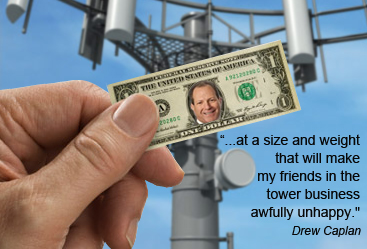 Hollywood, Fla. last week, citing LightSquared's entry into the market a welcomed plus to their expectations of strong earnings. Hollywood, Fla. last week, citing LightSquared's entry into the market a welcomed plus to their expectations of strong earnings.
Although LightSquared Chief Network Officer Drew Caplan confirmed that his company will build 40,000 sites, "give or take a few," he also cautioned the industry to curb its enthusiasm regarding lease rates, stating that the equipment on their structures will be "at a size and weight that will make my friends in the tower business awfully unhappy."
Speaking to a packed session prior to the tower titans' panel discussion, Caplan said the company's 40 MHz of L-band spectrum for LTE services in the 1.6 GHz band is the largest contiguous block of spectrum below 2 GHz.
He said that he was convinced that LightSquared has selected the right technology, has a strong spectrum position and has an attractive business model, adding that the nation's wireless industry "is an industry that is begging to be shaken up."
Regarding the equipment that will be installed at each site, Caplan told WirelessEstimator.com that he would rather not give the exact spec, "but I will say that one of the good things about the NSN solution is that we will have two boxes, not three and we'll fit nicely in our MLAs in terms of size and weight."
One tower leasing executive said that the initial equipment footprint being provided by LightSquared for MLA negotiations is approximately the size of a Clearwire installation.
"Granted, we won't be able to obtain a higher lease rate, but the benefit to us in certain instances is that the considerably reduced loading will not present a problem for sites that are near capacity," he said.
Caplan said that roughly 60 percent of LightSquared's towers will have fiber backhaul connections.
Using existing fiber will be cheaper and help the company roll out the network faster, he said.
What makes LightSquared different from other 4G operators, according to Caplan, is the horizontal model it will operate, and the fact that it will only have a maximum of between 500 to 700 employees.
"Every dollar that comes in from our investors and every dollar that comes in from our partner customers, after we've paid for those 500 to 700 people, is going to go to building the network," he said. "That's all we do."
Caplan said LightSquared's spectrum sits in a "sweet spot," and he unabashedly discussed the liabilities of his 4G competitors building LTE networks. He also said Clearwire, operating in the 2.5 GHz band, will suffer from poor propagation. "This is physics," he said.
LightSquared will start market trials next year and is aiming to have its 40,000 base stations up and running at the end of 2015, by which time it expects to cover 92 per cent of the US population through its terrestrial and satellite network.
The company is going to be wholesale-only and commercially neutral, allowing new players and new retail business models into the mobile market in the U.S.
LightSquared has said its LTE network will allow for terrestrial-only, satellite-only or integrated satellite-terrestrial services.
|
US tower counts and site information are often inaccurate and purposely misleading
September 27, 2010 - Reporters, analysts and consultants have a penchant for being able to spice their comments with newly farmed facts, especially in the wireless industry regarding the number of communications towers in America.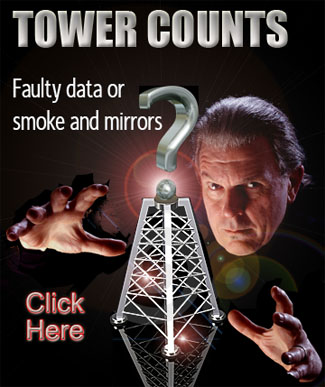
One noted researcher in an industry publication recently said that CTIA placed its most recent tower count at 242,130.
That number and most of the totals offered elsewhere appear to be incorrect, however, because they're based upon faulty databases, incorrect information that becomes the gospel once published, and what appears to be the natural marketing path for some companies to inflate tower counts and their capability to be co-located.
Tim House, director of marketing and sales for PCIA said that his trade organization that is holding its conference next week in Hollywood, Fla. does not track the number of towers in the US.
"We have attempted to do so in the past and may in the future, but have found it to be a daunting task," he said.
House said that he wanted to make sure that PCIA has an approach "that ensures accuracy."
Please see: Faulty databases and the Top Tower Companies
|
T-Mobile touts its first solar powered
cell tower site in Pennsylvania
September 25, 2010 - The small borough of Chalfont in Bucks County Pa. has been the home of T-Mobile's first solar powered cell site since February and the carrier said it's working fine, but full details on its success will not be provided until the end 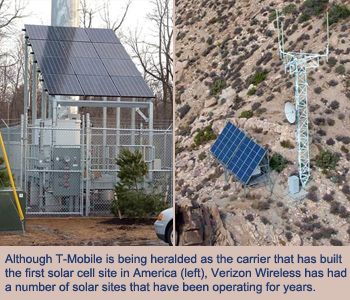 of the year. of the year.
“We wanted to test it and see if it was something that would enable us to operate one of our cell sites in the same fashion that we do today, at the same time being more environmentally conscious,” said Kerri Strike, the network engineering and operations director for T-Mobile’s Philadelphia and central Pennsylvania markets.
The site is located on Oak Avenue and has 12 solar panels facing south to maximize their exposure to the sun.
Strike said her T-Mobile market decided to test a solar-powered site because T-Mobile likes to try to partner with the communities it serves and the communities in the market are interested in the environment. It chose Chalfont for the site because it needed to put a site in the borough and the location met the requirements for a solar-powered one, the Philadelphia Business Journal reported last week,
So far, the site has been working fine. Strike isn’t ready to release data on how much it is saving T-Mobile in power costs because it has mostly been operational during the time when the area gets the most sun.
“We should have that available certainly by the end of the year,” she said.
Not only does T-Mobile get clean, renewable power from its solar installation - the utility that serves Chalfont, PECO, also benefits. PECO plans to buy 20 percent of its power from renewable sources, tech news site ZDNet.com reports.
Dozens of news portals have picked up Strike's comments and many of them are headlining T-Mobile's solar site as the first one constructed in America.
However, other carriers have experimented with solar installations in the past.
Over three years ago Verizon Wireless harnessed the power of the sun to extend its wireless network to remote areas. The site pictured above is in California’s remote desert. It is one of the company’s eight solar powered cell sites in the western United States.
|
If stock prices are an indicator...
PCIA show's towerco chiefs expected to provide positive outlook for the industry
September 14, 2010 - The nation's three public tower companies and two of the industry's largest private aggregators will again provide their state of the industry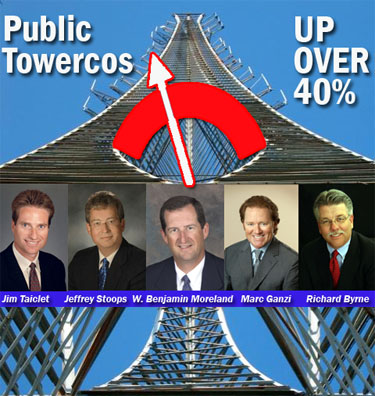 outlook during the PCIA - The Wireless Infrastructure Show, October 4-7 in Hollywood, Fla. outlook during the PCIA - The Wireless Infrastructure Show, October 4-7 in Hollywood, Fla.
Judging by the past three months' stock performance of Crown Castle International, SBA Communications and American Tower Corporation, investors are convinced that it will be profitable future, resulting in a 12% rise for American Tower, a climb of 10% for SBA and a healthy 8.3% for Crown Castle while the S&P 500 has only risen 1.8% during the same period.
In addition, all three companies have soared more than 40% over the past year.
Some analysts believe that prices are being raised by LightSquared's planned $7 billion wireless broadband network designed to manage 4G services. A total of 40,000 base stations will cover 92% of the U.S. population upon completion in 2014.
Drew Caplan, LightSquared's Chief Network Officer is expected to provide additional information regarding the company's plans at the upcoming show.
Caplan is leading the development and deployment of the company’s next generation network. In his first presentation since the formation of LightSquared, Caplan will speak about the new entrant’s plans for building its 4G-LTE network.
Providing an industry overview will be tower company CEOs Richard J. Byrne, TowerCo, LLC; Marc Ganzi, Global Tower Partners; W. Benjamin Moreland, Crown Castle, International; Jeffrey A. Stoops, SBA Communications; and Jim Taiclet, American Tower Corporation.
For additional information about 2010's show, click here.
|
NATE to OSHA: Sorry, it's over!
September 10, 2010 - Earlier this month the National Association of Tower Erectors Chairman Jim Coleman said that the NATE/OSHA National Partnership's 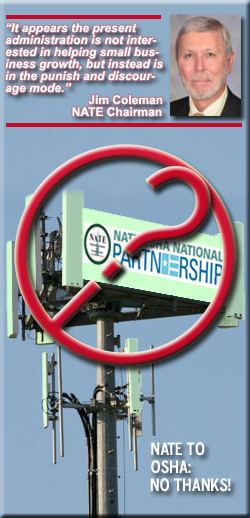 continuation was questionable due to the federal agency's reluctance to accommodate past benefits the partnership enjoyed. continuation was questionable due to the federal agency's reluctance to accommodate past benefits the partnership enjoyed.
Today, NATE announced that it has informed Assistant Secretary of Labor Dr. David Michaels that it could not agree to the terms and conditions of what appears to be a one-sided agreement and said that the partnership has ended.
NATE is the first trade organization in the nation that has decided not to renew its partnership with OSHA based upon the stripping of previous benefits that made the alliance a success - so much so that the NATE partnership is heralded on the OSHA website as a model of how enterprise and government can work towards mutual advances in safety.
For more than a year, NATE had been working diligently with OSHA to renew its national partnership. Through a determined effort, the erectors group believed it had the process completed earlier this summer when OSHA presented a final version of the document, and requested dates for a signing ceremony.
Unfortunately, according to NATE Executive Director Patrick Howey, the document had been stripped of the incentives for NATE members to participate, and NATE leaders no longer felt the agreement was in the association’s best interest.
OSHA had previously announced that – as a matter of agency policy – it was eliminating any reductions in penalty for good faith.
"The NATE/OSHA Partnership has always contained language allowing for such reductions. However, recognizing the importance of the program, NATE agreed to press on despite this change in policy," Howey said.
The final agreement, unfortunately, had removed additional benefits. In particular, the Focused Inspection Checklist – a document defining the crucial safety issues on tower sites on which both OSHA and NATE members would focus for safety – had been removed from the program.
"Ironically, this document was at the heart of the association’s earliest efforts to partner with OSHA and had created the atmosphere of cooperation for both organizations to pursue tower industry safety together."
"The agreement also eliminated language stating OSHA would not issue fines for hazards immediately abated, another incentive in all previous partnership documents. A final issue, regional authority to negotiate penalties, would reportedly still be allowed despite its absence from the agreement," Howey noted.
Although NATE attempted negotiations to have these items returned to the agreement, OSHA declined NATE’s requests and the organization saw no benefit in continuing the partnership.
"It appears the present administration is not interested in helping small business growth, but instead is in the punish and discourage mode. All the work between NATE and OSHA, which helped alleviate preconceived fears of the agency, may well fall by the wayside," said Coleman.
However, NATE is in the process of completing a replacement program for those members who want to take tower climber safety to a higher level.
Howey said that there will be more about this program in the coming weeks.
"Until then, I encourage everyone who was in the program to keep following the defined best practices. For those members who were not in the partnership with OSHA, I hope the new program will entice you to become involved in this endeavor," he said.
|
Deceased tech's mom sues employer; says he was free climbing when he fell
September 10, 2010 - The mother of a Wagoner, Oklahoma man who died when he 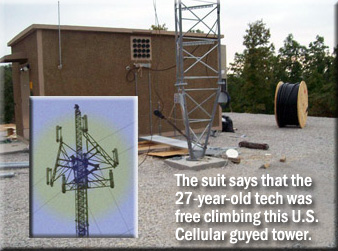 fell from a communications tower a year ago is suing her son’s employer in a wrongful death claim. fell from a communications tower a year ago is suing her son’s employer in a wrongful death claim.
Tina Stamps filed the action Thursday afternoon against S&S Communications Specialists Inc., headquartered in Hulbert. Stamps’ son, Justin, 27, was a tower technician for the company.
The suit contends Stamps was building a tower on a project in Oregon County Missouri on Sept. 14, 2009. He was 320 feet above the ground on the guyed tower, cutting a “downlead” electrical co-axial cord to lengthen it before re-taping it to the tower. Stamps’ work was conducted while he was “free climbing” on the tower, the suit said.
The suit claims S&S had “created and maintained an unsafe work environment” in violation of applicable OSHA standards and generally recognized industry standards. The suit alleges Stamps was not provided proper equipment, nor did the company ensure proper training programs were completed.
At the time of the accident, S&S co-owner Kenneth Shankle said that Stamps had been with his company for less than a year, but had experience with a number of companies prior to his employment.
The suit alleges S&S “knew or should have known” that directing Stamps to perform his assigned job duties on Sept. 14, 2009, under those circumstances created an “unreasonably dangerous work environment of such nature that S&S was substantially certain that serious injury and/or death would likely result.”
Stamps was “moving up” on the tower when he fell more than 300 feet to his death, Tina Stamps said following the tragedy.
“They were finished where they were working and getting ready to move up the tower,” Stamps said she was told by an S&S official. “He went to hook up, and he missed.”
S&S was constructing the tower for U.S. Cellular.
OSHA cited S&S for Duty to have fall protection, and Fall protection systems criteria and practices. They were fined $1,500 for each violation.
The suit seeks actual and exemplary damages in excess of $10,000. Tina Stamps is represented by Donald Bingham and Bruce Sewell.
|
Tech survives 100-foot fall in Pennsylvania
September 9, 2010 - A tower technician remained hospitalized today after falling approximately 100 feet from a monopole Tuesday afternoon in Lawrence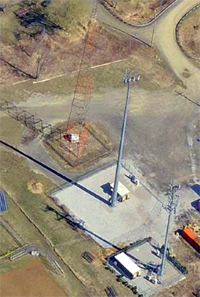 Park Township, Pa. Park Township, Pa.
The worker, whose name has not been released is employed by Sargent Electric Co., of Pittsburg.
According to the firm's safety manager, Matt Babilon, the man was changing out antennas at 1381 Nagle Road when he suddenly fell.
The accident location has two monopoles side-by-side, but the structure that the worker fell from, its owner and the company Sargent Electric Co., Inc. was working for have not been released.
Babilon said that the tech had been using the proper safety equipment, "but something apparently failed."
Officials with the federal Occupational Safety and Health Administration went to the accident scene and took the fall-protection equipment for testing, Babilon said.
OSHA Area Director Theresa Naim said yesterday that the agency is investigating the fall protection equipment and the company's fall-protection program.
The man was taken to Hamot Medical Center. He remained there Wednesday but was responsive, talking and mobile.
Babilon said this morning that the worker was doing "remarkably well, considering what happened."
Sargent Electric's divisions employ over 400 workers. The 103-year-old company provides all aspects of wireless construction, from raw land builds to site maintenance.
Its published lost time incident rate is .16, along with an interstate EMR of .57 and an intrastate EMR of .27.
The electrical contractor is an approved contractor of a number of major tower companies.
|
ATC agrees to take Coltel's Colombia assets
September 8, 2010 - American Tower Corporation's Colombian subsidiary, ATC  Sitios de Colombia S.A.S., announced that it has launched operations in Colombia, where it recently entered into an agreement to purchase the exclusive use rights for up to 458 wireless communication tower sites from Telefonica S.A.'s Colombian subsidiary, Colombia Telecomunicaciones S.A. E.S.P. Sitios de Colombia S.A.S., announced that it has launched operations in Colombia, where it recently entered into an agreement to purchase the exclusive use rights for up to 458 wireless communication tower sites from Telefonica S.A.'s Colombian subsidiary, Colombia Telecomunicaciones S.A. E.S.P.
The Boston-based company did not indicate the agreement price for the towers.
ATC has completed the purchase of use rights for 225 of these tower sites, on which Coltel is the anchor tenant, and expects to close on the remaining sites by the end of 2010, subject to customary closing conditions.
In addition, the parties contemplate a follow-on purchase of use rights for up to an additional 514 wireless communication tower sites by the end of 2011.
"This transaction extends our presence into yet another growing Latin American wireless market where our existing customers currently operate," said Jim Taiclet, Chairman, President and Chief Executive Officer. "Our platform for growth in Latin America is strong, with now five served markets where wireless carriers are focused on investing to deploy additional spectrum and launch new data services."
With the 225 new Colombian assets, ATC owns approximately 32,693 towers, according to company records.
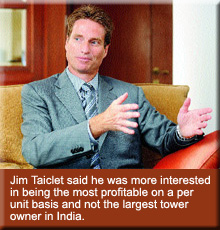 ATC's strongest international presence is in India where they own 7,400 towers. Their largest competitor in India would have been GTL, but the company announced recently that it would not go through with the announced deal of acquiring 50,000 towers owned by Anil Ambani-led Reliance Communications. ATC's strongest international presence is in India where they own 7,400 towers. Their largest competitor in India would have been GTL, but the company announced recently that it would not go through with the announced deal of acquiring 50,000 towers owned by Anil Ambani-led Reliance Communications.
Prior to that announcement, Taiclet told an Indian reporter, "We are not seeking to be the largest tower company in India. We are only seeking to be the most profitable on a per unit basis. And right now, our view is that we’ve achieved a platform level of size now. Therefore, additional investments have to be extremely attractive,” he said.
News articles in India's media state ATC is reportedly taking another look at Reliance's towers.
The Business Standard reported that Reliance has begun talks with a consortium of two to three private equity funds. The VC players could also bring in a tower company as a partner in the consortium. The company has been valued at $11 billion.
|
Monopole flames quelled, but claims keep coming
September 2, 2010 - Some risk managers subscribe to the Yogi Berra claims closure doctrine of "It ain't over 'til it's over," as underscored in a lawsuit recently filed against a tower owner and a contractor for reimbursement of damages alleged to have occurred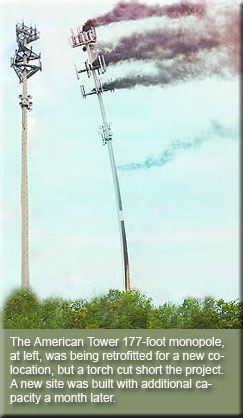 over three years ago in Michigan when a monopole's transmission lines caught on fire. over three years ago in Michigan when a monopole's transmission lines caught on fire.
SET SEG, a Lansing-Michigan-based company that insures the Howell district and more than 400 other Michigan school systems, filed a complaint against American Towers Inc., a subsidiary of American Tower Corporation, and Commstructures Inc. of Florida, stating the fire and subsequent damage were a result of negligence of the defendants. Howell Public Schools is not a party to the suit.
The insurance company is seeking an unspecified amount from the two defendants.
Wayne Geik, the attorney representing the defendants, in his answer said the plaintiff's complaint is defective since it did not include a copy of the insurance policy.
Geik also wrote that any damage sustained by school district buildings and land was caused by something other than negligence.
While working on a reinforcement project to add additional capacity to the monopole on July 24, 2007, the contractor accidentally set the structure's transmission lines on fire, causing the monopole to be completely destroyed.
The fire, which started at about 9 a.m., burned itself out by 10 a.m., but left a leaning unstable 177-foot telecommunications tower that served AT&T, Sprint, and carried the internet connections for five Howell schools.
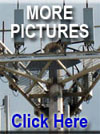 At that time Paul Roberts, Vice President of Compliance for American Tower, said there was a very low probability that the tower would topple. He said the steel structure sometimes straightens itself out when it cools following the fire. At that time Paul Roberts, Vice President of Compliance for American Tower, said there was a very low probability that the tower would topple. He said the steel structure sometimes straightens itself out when it cools following the fire.
"However, we take no chances," Roberts said. "We will keep a 250-foot clearance until we can get a crane out there and it's secured."
A new structure was installed a month later.
In addition to the carriers' losses, the fire caused damage to 10 wireless radar-transmitting computers and associated cables and equipment owned by Howell schools.
-----------
|
 |
|